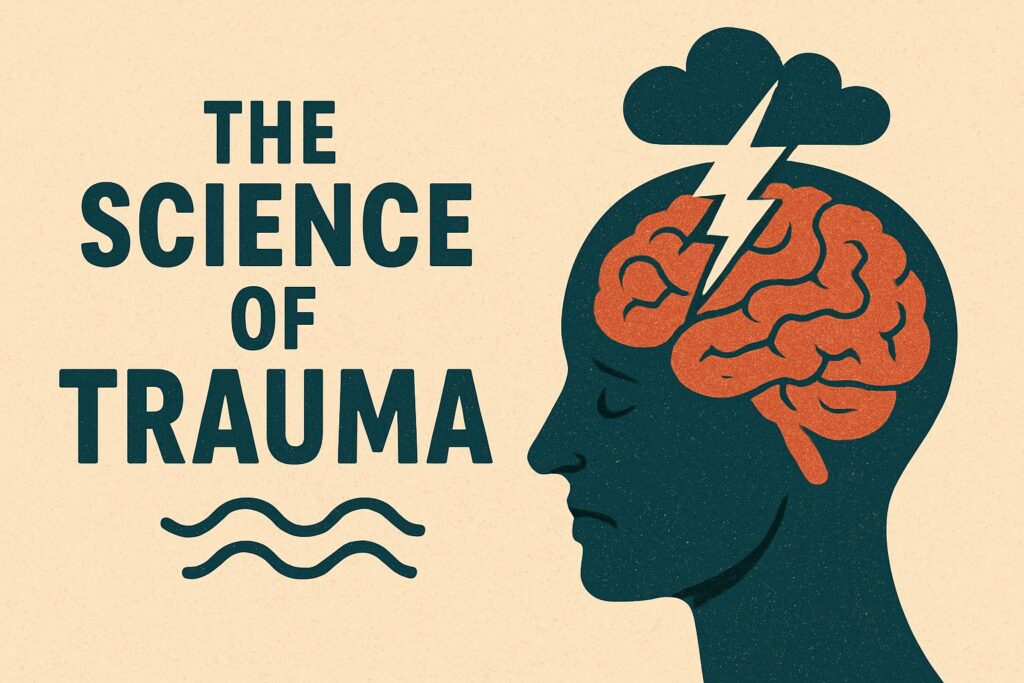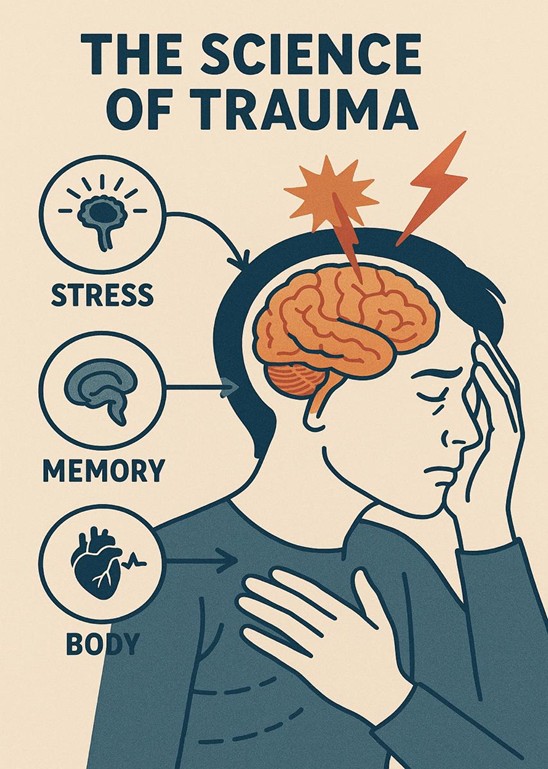
What Is Trauma, Really?
Trauma isn’t just about what happened to you—it’s about how your body processed and stored the event.
You can think of trauma as unfinished stress that gets trapped in your nervous system. This can result from:
- Emotional neglect or abuse
- Car accidents or medical procedures
- Betrayals or toxic relationships
- Even seemingly “small” events that overwhelmed your capacity .This is often called nervous system dysregulation or trauma-induced freeze response.
The Brain on Trauma
When we experience trauma, our brain’s alarm system—especially the amygdala, hippocampus, and prefrontal cortex—goes into overdrive.
- Amygdala: This is the brain’s fear center. It becomes hyperactive during and after trauma, making us more sensitive to perceived threats.
- Hippocampus: This structure helps process and store memories. Trauma can shrink the hippocampus, affecting how we recall events and distinguishing between past and present.
- Prefrontal cortex: Responsible for decision-making and rational thought, this part often becomes less active, reducing our ability to regulate emotions and assess danger logically.
This altered brain function explains why trauma survivors may have flashbacks, nightmares, and emotional numbing, or may be easily startled.
The Role of the Nervous System in Trauma
Your autonomic nervous system has one job: to keep you safe. It has two key branches:
- Sympathetic Nervous System (Fight or Flight): Activates when you perceive danger
- Parasympathetic Nervous System (Freeze or Shutdown): Slows everything down when the danger feels overwhelming
When trauma hits, your body often goes into survival mode—and gets stuck there.
That’s why you may:
- Overreact to small stressors
- Struggle with decision-making
- Feel disconnected from your body or emotions
- Repeat toxic patterns, even when you know better
Psych fact: These are not personality flaws. They’re biological adaptations that once kept you safe.
Why You Can’t “Think” Your Way Out of Trauma
Trauma lives in the body, not just the mind.
Traditional talk therapy can be helpful, but it may fall short if it doesn’t address the somatic (body-based) components of healing. That’s because trauma disrupts the brain-body connection, especially areas like:
- The amygdala (fear center)
- The hippocampus (memory and time)
- The prefrontal cortex (rational thinking)
When these systems are dysregulated, your body keeps reacting like the trauma is still happening—even years later.
Signs Your Nervous System Is Stuck in Trauma Mode
- Chronic fatigue or anxiety
- Hypervigilance or emotional numbness
- People-pleasing or avoiding conflict
- Difficulty trusting others
- Feeling “off” but not knowing why
If this sounds familiar, your nervous system is not broken—it’s doing its job too well. It learned to survive. Now, it needs help learning how to feel safe again.
How to Heal: Rewiring the Nervous System
The good news? Your nervous system is neuroplastic, meaning it can change with the right support.
Here are trauma-informed, science-backed ways to start:
- Somatic Therapy
Modalities like Somatic Experiencing, TRE (Tension & Trauma Release Exercises), or Sensorimotor Psychotherapy help release stored trauma from the body.
- Polyvagal Exercises
Developed from the Polyvagal Theory, these techniques tone the vagus nerve and help restore feelings of safety and connection.
- Safe Relationships
Co-regulation (being with calm, attuned people) teaches your system that it’s safe to relax.
- Mindfulness and Breathwork
Slow, diaphragmatic breathing can signal your body to exit fight-or-flight mode.
- Professional Guidance
Working with a trauma-informed therapist or coach can guide you through deeper healing work.
Final Thoughts: You’re Not Broken—You’re Wired for Survival
If you’ve ever felt stuck, anxious, or disconnected, you’re not weak. You’re trauma-informed—and you’re beginning to understand why your nervous system is doing what it does.
The more compassion you show yourself, the easier healing becomes.
You don’t have to stay stuck. Your body is not your enemy—it’s your ally in recovery.
Real Talk: You Don’t Need to “Fix” Yourself
Let’s be clear—healing trauma isn’t about becoming someone new. It’s about coming back home to who you were before the world taught you to disconnect from yourself.
You’re not too sensitive.
You’re not lazy.
You’re not broken.
You are trauma-aware—and that means you can begin the work of healing, regulation, and restoration.
Ready to Begin Your Healing Journey?
Start by listening to your body. Then give it the support it needs to feel safe, calm, and whole again.
🧠💛 You deserve to feel free—not just in your mind, but in your entire nervous system.





